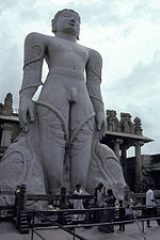
Seven Wonders of India
Encyclopedia
Various lists of the Wonders of the World
have been compiled over the ages to catalogue the most spectacular man-made constructions and natural things in the world. But, for the first time the Times of India (TOI) News paper carried out a SMS poll, from 21 July to 31 July 2007, to vote for the seven greatest wonders of India
, out of a list of 20 identified ancient or mediaeval sites for the purpose. The Seven Wonders of India (four of them are UNESCO World Heritage Sites) have now been chosen by the readers of Times of India (TOI) only. The winners range from a majestic monolith to places of worship, a mausoleum and a university.
Except for the Golden Temple
and the Taj Mahal
, the Seven Wonders are all located in small towns or in the countryside. However, four of the twenty monuments listed for voting are located in three metropolitan area, such as Delhi
's Lotus Temple
and Qutab Minar, the Victoria Terminus at Bombay and the Howrah Bridge
at Kolkatta.
The seven wonders of India, in the order of their voting are the following:
1. Gomateshwara - a place called Shravanabelagola in the Hassan district of Karnataka
state
2. Harmandir Sahib
(Golden temple) - located in the city of Amritsar
in Punjab
3. Taj Mahal
- located in Agra
, Uttar Pradesh
4. Hampi
- located in a village in northern Karnataka
5. Konark Sun Temple
- located a small town in the state of Orissa
6. Nalanda
- an ancient university near Patna
in Bihar
7. Khajuraho
- a village in the Indian state of Madhya Pradesh
Brief details are provided below, while individually more details are provided in linked wiki pages.
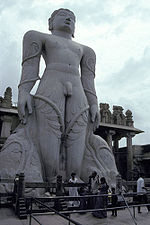 The colossal monolithic statue of Gomateshwara (Shravanabelagola is a synonymous word), also called as Bahubali the Jain saint, created around 983 C.E by Chamundaraya, a minister of the Ganga King, Rachamalla (Raachmalla SathyaVaak IV 975-986 C.E) is located atop the Chandragiri hill (618 steps climb leads to the monolith on the hill), near the town of Shravanabelagola in Karnataka
The colossal monolithic statue of Gomateshwara (Shravanabelagola is a synonymous word), also called as Bahubali the Jain saint, created around 983 C.E by Chamundaraya, a minister of the Ganga King, Rachamalla (Raachmalla SathyaVaak IV 975-986 C.E) is located atop the Chandragiri hill (618 steps climb leads to the monolith on the hill), near the town of Shravanabelagola in Karnataka
state. This statue is said to have been carved out of a single block of fine-grained white granite and is considered of great religious significance because Jains believe Bahubali
was the first to attain moksha
(freedom from cycle of birth and death). The image stands on a lotus. It has no support up to the thighs and is 60 feet (18.3 m) tall with the face measuring 6.5 feet (2 m). The statue is completely in the nude in the Jain custom and is visible from a distance of 30 km. With the serene expression on the face of the image, its curled hair with graceful locks, its proportional anatomy, the monolith size, and the combination of its artistry and craftsmanship have led it to be called the mightiest achievement in sculptural art in medieval Karnataka It is the largest monolithic statue in the world.
The neighboring areas of Shravanabelagola
, apart from the Gomateshwara statue, have Jaina bastis and several images of the Jaina Tirthankar
s. A beautiful view of the surrounding areas could be seen from the top of the Chandragiri Hill
. Every 12 years, thousands of devotees congregate here to perform the Mahamastakabhisheka
, a spectacular ceremony in which the thousand-year-old statue is anointed with milk, curds, ghee, saffron and gold coins. The anointing last took place in February 2006, and the next ceremony will occur in 2018.
 The Harmandir Sahib
The Harmandir Sahib
or Darbar Sahib, informally referred to as the Golden Temple or Temple of God, is culturally the most significant shrine of the Sikh
s and one of the oldest Sikh Gurudwara. It is located in the city of Amritsar
, which was established by Guru Ram Das, the fourth guru of the Sikhs and the city that it was built in, is also due to the shrine known as Amritsar
.
The fourth Guru of Sikhism, Guru Ram Das, excavated a tank in 1577 C.E which subsequently became known as Amritsar
or Amrit Sarovar (meaning: Pool of the Nectar of Immortality), giving its name to the city that grew around it. In due course, a splendid Sikh edifice, Harmandir Sahib
(meaning: The abode of God), rose in the middle of this tank and became the supreme center of Sikhism
. Its sanctum houses the Adi Granth
, compiled by Guru Arjun Dev, comprising compositions of Sikh Gurus and other saints considered to have Sikh values and philosophies e.g. Baba Farid, Kabir
.
Devotees, for whom the temple is a symbol of freedom and spiritual independence, come here from all over the world to enjoy its environs and offer their prayers. The Golden Temple sits on a rectangular platform, surrounded by a pool of water called the Amrit Sarovar. The temple building has four entrances instead of the usual single entry. This is symbolic of the openness of Sikhism
and indicates that followers of all faiths are allowed inside. The walls within are decorated with carved wooden panels and elaborate inlay work in silver and gold. The Adi Granth
, rests on a throne beneath a jewel-encrusted canopy. Priests conduct continuous recitation of verses from the holy book.
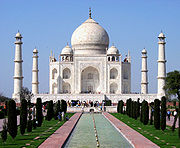 Taj Mahal (also "the Taj"), the pinnacle of Mughal architecture
Taj Mahal (also "the Taj"), the pinnacle of Mughal architecture
, was built by the Mughal emperor Shah Jahan in memory of his queen Mumtaz Mahal
. It is considered the finest example of Mughal architecture, a style that combines elements from Persian, Ottoman, Indian
, and Islamic
architectural styles. In 1983, the Taj Mahal became a UNESCO World Heritage Site and was cited as "the jewel of Muslim art
in India and one of the universally admired masterpieces of the world's heritage." It is an integrated symmetric complex of structures that was completed around 1648. Ustad Ahmad Lahauri
is generally considered to be the principal designer of the Taj Mahal.
The focus of the Taj Mahal is the white marble tomb, which stands on a square plinth
consisting of a symmetrical building with an iwan
, an arch-shaped doorway, topped by a large dome. Like most Mughal tombs, basic elements are Persian in origin. The base structure is a large, multi-chambered structure. The base is essentially a cube with chamfer
ed edges and is roughly 55 meters on each side (see floor plan, right). On the long sides, a massive pishtaq, or vaulted archway, frames with a similar arch-shaped balcony. On either side of the main arch, additional pishtaqs are stacked above and below. This motif of stacked pishtaqs is replicated on chamfered corner areas as well. The design is completely symmetrical on all sides of the building. Four minaret
s, one at each corner of the plinth, facing the chamfered corners, frame the tomb. The main chamber houses the false sarcophagi of Mumtaz Mahal and Shah Jahan; their actual graves are at a lower level. The exterior decorations of the Taj Mahal are among the finest to be found in Mughal architecture. The calligraphy found are of florid thuluth
script, created by Persian calligrapher Amanat Khan.
Masons, stonecutters, inlayers, carvers, painters, calligraphers, dome-builders and other artisans were requisitioned from the whole of the empire and also from Central Asia and Iran to build the monument. While bricks for internal constructions were locally prepared, white marble for external use in veneering work was obtained from Makrana in Rajasthan. Semi-precious stones for inlay ornamentation were brought from distant regions of India, Ceylon (Sri Lanka) and Afghanistan. Red sandstone of different tints was requisitioned from the neighboring quarries of Fatehpur Sikri
and Dholpur
. It took 17 years for the Taj to be built.

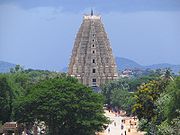 .
.
Ruins of Hampi
(UNESCO World Heritage Site), presents the Vijayanagara architecture, a vibrant combination of the Chalukya, Hoysala, Pandya, and Chola styles, idioms that prospered in previous centuries. Hampi was the last capital of the Vijayanagar Empire, which was admired by the travelers between the 14th and 16th centuries. But it was pillaged and abandoned by the Muslim confederacy which conquered the Deccan in 1565 C.E. Palaces, temples, marketplaces, watch towers, stables, baths and monoliths lie scattered amidst huge boulders, which complement the rugged look and historic feel of the place.
Its legacy of sculpture, architecture and painting influenced the development of the arts long after the empire came to an end. Its stylistic hallmark is the ornate pillared Kalyanamantapa (marriage hall), Vasanthamantapa (open pillared halls) and the Rajagopura (tower). While the empire's monuments are spread over the whole of Southern India, nothing surpasses the vast open air theater of monuments at its capital at Vijayanagara.
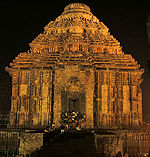 .
.
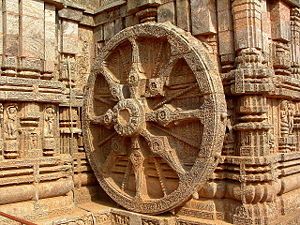 Konark Sun Temple
Konark Sun Temple
(also known as the Black Pagoda), was built in black granite
by King Narasimhadeva I
(1236 C.E-1264 C.E) of the Eastern Ganga Dynasty
. The temple is a UNESCO World Heritage Site. Built in the 13th century, the temple is designed in the shape of a colossal chariot with 24 wheels (3.3 m dia diameter each) drawn by seven horses and, carrying the Sun god, Surya
, across the heavens. It is a stunning monument of religious (Brahmanical) architecture...
The Sun temple belongs to the Kalinga
School of Indian Temples with characteristic curvilinear towers mounted by cupolas and is aligned in the east-west direction as it is dedicated to Sun, which sun lights the entrance. The temple plan depicts three segments, viz., Natmandir (the outer complex), Jagmohan (the central complex) and Garbhagriha (the main complex housing the Deity). The main sanctum which (69.8 m. high) was constructed along with the audience hall (39.5 m. high) having elaborate external projections. The main sanctum which enshrined the presiding deity has fallen off. The Audience Hall survives in its entirely, but only small portions of the Dancing Hall (Nata Mandir) and the Dining Hall (Bhoga-Mandap) have survived the vagaries of time. The Temple compound measures the temple compound measures 857 ft (261.2 m) by 540 ft (164.6 m).
The entrance to the temple is guarded by two lions, each shown crushing a war elephant. Each elephant in turn is shown on top of a human body. At the entrance, there is also a Nata Mandir or dance hall where the temple dancers used to perform dances in homage to the Sun god. All around the temple, there are various floral and geometric patterns. There are also human, divine and semi-divine figures in sensuous poses. The poses contains couples in various amorous postures, and are derived from the Kama Sutra
.
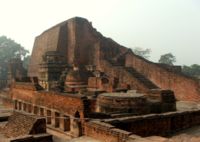 The Nalanda, located in the Indian State of Bihar
The Nalanda, located in the Indian State of Bihar
. It was a Buddhist
center of learning from 427 C.E to 1197 C.E partly under the Pala Empire
. It has been called "one of the first great universities in recorded history.". According to historical studies the University of Nalanda was established 450 C.E under the patronage of the Gupta emperors
, notably Kumaragupta. Nalanda, considered as the world's first residential university, had dormitories for students and had accommodated over 10,000 students and 2,000 teachers.
The university was considered an architectural masterpiece, and was marked by a lofty wall and one gate. Nalanda had eight separate compounds and ten temples, along with many other meditation halls and classrooms. On the grounds were lakes and parks. The library was located in a nine storied building where meticulous copies of texts were produced. The subjects taught at Nalanda University covered every field of learning, and it attracted pupils and scholars from Korea, Japan, China, Tibet, Indonesia, Persia and Turkey. The Tang Dynasty
Chinese
pilgrim Xuanzang
left detailed accounts of the university in the 7th century.
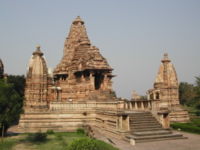
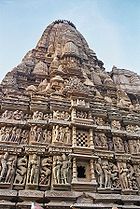 Khajuraho
Khajuraho
has the largest group of medieval (between 950 C.E and 1050 C.E) temples of Hindu
, Buddhist and Jain religions. There is perfect fusion of architecture and sculpture at this temple complex, famous for their erotic sculpture. The temples are a UNESCO World Heritage Site. At the Temple of Kandariya, there is a profusion of decorated sculptures considered as one of the greatest masterpieces of Indian art.
Built by Chandela
dynasty, the temples exhibit stunningly explicit sexual sculptures which were created by the artist's imagination of lovemaking positions prevalent at that time, or based on the rules outlined in the Kama Sutra
. Many of the sculptors have claimed artistic ownership on many sculptures. Built of sandstone in varying shades of buff, pink or pale yellow, most of the temples belong to the Shiva
, Vaishnava or Jaina
religious sect
s, which are difficult to differentiate from one another. The temples, sited in an east-west direction, depicts a plan with spacious layout with interior rooms inter connected. An entrance, a hall, a vestibule and a sanctum are part the common layout plan of the temples. It is stated that the Khajuraho temples are a celebration of womankind, her innumerable moods and facets which are witnessed by the carvings of a woman writing letter, applying makeup to her eyes, combing her tresses, dancing, and playing with her child. Also etched, sculpted with consummate skill are innocent, coquettish, smiling, seductive, passionate and beautiful and erotic sculptures depicted in intricate detail. It is also opined that the Chandelas followed the Tantric
cult with the faith that gratification of earthly desires is a step towards attaining Nirvana, the infinite liberation,.
Wonders of the World
Various lists of the Wonders of the World have been compiled from antiquity to the present day, to catalogue the world's most spectacular natural wonders and manmade structures....
have been compiled over the ages to catalogue the most spectacular man-made constructions and natural things in the world. But, for the first time the Times of India (TOI) News paper carried out a SMS poll, from 21 July to 31 July 2007, to vote for the seven greatest wonders of India
India
India , officially the Republic of India , is a country in South Asia. It is the seventh-largest country by geographical area, the second-most populous country with over 1.2 billion people, and the most populous democracy in the world...
, out of a list of 20 identified ancient or mediaeval sites for the purpose. The Seven Wonders of India (four of them are UNESCO World Heritage Sites) have now been chosen by the readers of Times of India (TOI) only. The winners range from a majestic monolith to places of worship, a mausoleum and a university.
Except for the Golden Temple
Harmandir Sahib
The Harmandir Sahib also Darbar Sahib , also referred to as the Golden Temple, is a prominent Sikh gurdwara located in the city of Amritsar, Punjab . Construction of the gurdwara was begun by Guru Ram Das, the fourth Sikh Guru, and completed by his successor, Guru Arjan Dev...
and the Taj Mahal
Taj Mahal
The Taj Mahal is a white Marble mausoleum located in Agra, India. It was built by Mughal emperor Shah Jahan in memory of his third wife, Mumtaz Mahal...
, the Seven Wonders are all located in small towns or in the countryside. However, four of the twenty monuments listed for voting are located in three metropolitan area, such as Delhi
Delhi
Delhi , officially National Capital Territory of Delhi , is the largest metropolis by area and the second-largest by population in India, next to Mumbai. It is the eighth largest metropolis in the world by population with 16,753,265 inhabitants in the Territory at the 2011 Census...
's Lotus Temple
Lotus Temple
The Bahá'í House of Worship in Delhi, India, popularly known as the Lotus Temple due to its flowerlike shape, is a Bahá'í House of Worship and also a prominent attraction in Delhi. It was completed in 1986 and serves as the Mother Temple of the Indian subcontinent...
and Qutab Minar, the Victoria Terminus at Bombay and the Howrah Bridge
Howrah Bridge
The Howrah Bridge is a cantilever bridge that spans the Hooghly River in West Bengal, India. Commissioned in 1943, the bridge was originally named the New Howrah Bridge, because it links the city of Howrah to its twin city, Kolkata . On 14 June 1965 it was renamed Rabindra Setu, after Rabindranath...
at Kolkatta.
The seven wonders of India, in the order of their voting are the following:
1. Gomateshwara - a place called Shravanabelagola in the Hassan district of Karnataka
Karnataka
Karnataka , the land of the Kannadigas, is a state in South West India. It was created on 1 November 1956, with the passing of the States Reorganisation Act and this day is annually celebrated as Karnataka Rajyotsava...
state
2. Harmandir Sahib
Harmandir Sahib
The Harmandir Sahib also Darbar Sahib , also referred to as the Golden Temple, is a prominent Sikh gurdwara located in the city of Amritsar, Punjab . Construction of the gurdwara was begun by Guru Ram Das, the fourth Sikh Guru, and completed by his successor, Guru Arjan Dev...
(Golden temple) - located in the city of Amritsar
Amritsar
Amritsar is a city in the northern part of India and is the administrative headquarters of Amritsar district in the state of Punjab, India. The 2001 Indian census reported the population of the city to be over 1,500,000, with that of the entire district numbering 3,695,077...
in Punjab
Punjab (India)
Punjab ) is a state in the northwest of the Republic of India, forming part of the larger Punjab region. The state is bordered by the Indian states of Himachal Pradesh to the east, Haryana to the south and southeast and Rajasthan to the southwest as well as the Pakistani province of Punjab to the...
3. Taj Mahal
Taj Mahal
The Taj Mahal is a white Marble mausoleum located in Agra, India. It was built by Mughal emperor Shah Jahan in memory of his third wife, Mumtaz Mahal...
- located in Agra
Agra
Agra a.k.a. Akbarabad is a city on the banks of the river Yamuna in the northern state of Uttar Pradesh, India, west of state capital, Lucknow and south from national capital New Delhi. With a population of 1,686,976 , it is one of the most populous cities in Uttar Pradesh and the 19th most...
, Uttar Pradesh
Uttar Pradesh
Uttar Pradesh abbreviation U.P. , is a state located in the northern part of India. With a population of over 200 million people, it is India's most populous state, as well as the world's most populous sub-national entity...
4. Hampi
Hampi
Hampi is a village in northern Karnataka state, India. It is located within the ruins of Vijayanagara, the former capital of the Vijayanagara Empire. Predating the city of Vijayanagara, it continues to be an important religious centre, housing the Virupaksha Temple, as well as several other...
- located in a village in northern Karnataka
Karnataka
Karnataka , the land of the Kannadigas, is a state in South West India. It was created on 1 November 1956, with the passing of the States Reorganisation Act and this day is annually celebrated as Karnataka Rajyotsava...
5. Konark Sun Temple
Konark Sun Temple
Konark Sun Temple is a 13th-century Sun Temple , at Konark, in Orissa. It was constructed from oxidized and weathered ferruginous sandstone by King Narasimhadeva I of the Eastern Ganga Dynasty. The temple is an example of Orissan architecture of Ganga dynasty...
- located a small town in the state of Orissa
Orissa
Orissa , officially Odisha since Nov 2011, is a state of India, located on the east coast of India, by the Bay of Bengal. It is the modern name of the ancient nation of Kalinga, which was invaded by the Maurya Emperor Ashoka in 261 BC. The modern state of Orissa was established on 1 April...
6. Nalanda
Nalanda
Nālandā is the name of an ancient center of higher learning in Bihar, India.The site of Nalanda is located in the Indian state of Bihar, about 55 miles south east of Patna, and was a Buddhist center of learning from the fifth or sixth century CE to 1197 CE. It has been called "one of the...
- an ancient university near Patna
Patna
Paṭnā , is the capital of the Indian state of Bihar and the second largest city in Eastern India . Patna is one of the oldest continuously inhabited places in the world...
in Bihar
Bihar
Bihar is a state in eastern India. It is the 12th largest state in terms of geographical size at and 3rd largest by population. Almost 58% of Biharis are below the age of 25, which is the highest proportion in India....
7. Khajuraho
Khajuraho
The Khajuraho Group of Monuments in Khajuraho , a town in the Indian state of Madhya Pradesh, located in Chhatarpur District, about southeast of New Delhi, are one of the most popular tourist destinations in India. Khajuraho has the largest group of medieval Hindu and Jain temples, famous for...
- a village in the Indian state of Madhya Pradesh
Madhya Pradesh
Madhya Pradesh , often called the Heart of India, is a state in central India. Its capital is Bhopal and Indore is the largest city....
Brief details are provided below, while individually more details are provided in linked wiki pages.
Shravanabelagola or Gomateshwara

Karnataka
Karnataka , the land of the Kannadigas, is a state in South West India. It was created on 1 November 1956, with the passing of the States Reorganisation Act and this day is annually celebrated as Karnataka Rajyotsava...
state. This statue is said to have been carved out of a single block of fine-grained white granite and is considered of great religious significance because Jains believe Bahubali
Bahubali
According to Jainism, Bahubali, called Gomateshwara , was the second of the hundred sons of the first Tirthankara, Rishabha, and king of Podanpur. The Adipurana, a 10th century Kannada text by Jain poet Adikavi Pampa According to Jainism, Bahubali, called Gomateshwara , was the second of the...
was the first to attain moksha
Moksha
Within Indian religions, moksha or mukti , literally "release" , is the liberation from samsara and the concomitant suffering involved in being subject to the cycle of repeated death and reincarnation or rebirth.-Origins:It is highly probable that the concept of moksha was first developed in...
(freedom from cycle of birth and death). The image stands on a lotus. It has no support up to the thighs and is 60 feet (18.3 m) tall with the face measuring 6.5 feet (2 m). The statue is completely in the nude in the Jain custom and is visible from a distance of 30 km. With the serene expression on the face of the image, its curled hair with graceful locks, its proportional anatomy, the monolith size, and the combination of its artistry and craftsmanship have led it to be called the mightiest achievement in sculptural art in medieval Karnataka It is the largest monolithic statue in the world.
The neighboring areas of Shravanabelagola
Shravanabelagola
Shravana Belgola is a city located in the Hassan district in the Indian state of Karnataka and is 158 km from Bangalore. The statue of Gommateshvara Bahubali at Śravaṇa Beḷgoḷa is one of the most important pilgrimage destinations in Jainism, one that reached a peak in architectural and sculptural...
, apart from the Gomateshwara statue, have Jaina bastis and several images of the Jaina Tirthankar
Tirthankar
In Jainism, a ' |ford]]-Maker", ) is a human being who achieves moksa through asceticism and who then becomes a role-model and teacher for those seeking spiritual guidance....
s. A beautiful view of the surrounding areas could be seen from the top of the Chandragiri Hill
Chandragiri Hill
Chandragiri is one of the two hills in Shravanabelagola in the Indian state of Karnataka, the other one being Vindhyagiri.-History:The recorded history surrounding the hill started in 300 BC when Shruthakevali, Bhadrabahu and Chandragupta Maurya visited the place in order to attain religious peace...
. Every 12 years, thousands of devotees congregate here to perform the Mahamastakabhisheka
Mahamastakabhisheka
The Mahamasthakabhisheka is an important Jain festival held once every twelve years in the town of Shravanabelagola in Karnataka, India. The festival is held in veneration of an immense 18 meter high statue of the siddha Bahubali...
, a spectacular ceremony in which the thousand-year-old statue is anointed with milk, curds, ghee, saffron and gold coins. The anointing last took place in February 2006, and the next ceremony will occur in 2018.
Golden temple or Harmandir Sahib

Harmandir Sahib
The Harmandir Sahib also Darbar Sahib , also referred to as the Golden Temple, is a prominent Sikh gurdwara located in the city of Amritsar, Punjab . Construction of the gurdwara was begun by Guru Ram Das, the fourth Sikh Guru, and completed by his successor, Guru Arjan Dev...
or Darbar Sahib, informally referred to as the Golden Temple or Temple of God, is culturally the most significant shrine of the Sikh
Sikh
A Sikh is a follower of Sikhism. It primarily originated in the 15th century in the Punjab region of South Asia. The term "Sikh" has its origin in Sanskrit term शिष्य , meaning "disciple, student" or शिक्ष , meaning "instruction"...
s and one of the oldest Sikh Gurudwara. It is located in the city of Amritsar
Amritsar
Amritsar is a city in the northern part of India and is the administrative headquarters of Amritsar district in the state of Punjab, India. The 2001 Indian census reported the population of the city to be over 1,500,000, with that of the entire district numbering 3,695,077...
, which was established by Guru Ram Das, the fourth guru of the Sikhs and the city that it was built in, is also due to the shrine known as Amritsar
Amritsar
Amritsar is a city in the northern part of India and is the administrative headquarters of Amritsar district in the state of Punjab, India. The 2001 Indian census reported the population of the city to be over 1,500,000, with that of the entire district numbering 3,695,077...
.
The fourth Guru of Sikhism, Guru Ram Das, excavated a tank in 1577 C.E which subsequently became known as Amritsar
Amritsar
Amritsar is a city in the northern part of India and is the administrative headquarters of Amritsar district in the state of Punjab, India. The 2001 Indian census reported the population of the city to be over 1,500,000, with that of the entire district numbering 3,695,077...
or Amrit Sarovar (meaning: Pool of the Nectar of Immortality), giving its name to the city that grew around it. In due course, a splendid Sikh edifice, Harmandir Sahib
Harmandir Sahib
The Harmandir Sahib also Darbar Sahib , also referred to as the Golden Temple, is a prominent Sikh gurdwara located in the city of Amritsar, Punjab . Construction of the gurdwara was begun by Guru Ram Das, the fourth Sikh Guru, and completed by his successor, Guru Arjan Dev...
(meaning: The abode of God), rose in the middle of this tank and became the supreme center of Sikhism
Sikhism
Sikhism is a monotheistic religion founded during the 15th century in the Punjab region, by Guru Nanak Dev and continued to progress with ten successive Sikh Gurus . It is the fifth-largest organized religion in the world and one of the fastest-growing...
. Its sanctum houses the Adi Granth
Adi Granth
Adi Granth is the early compilation of the Sikh Scriptures by Sri Guru Arjan Dev Ji, the fifth Sikh Guru, in 1604. This Granth is the Holy Scripture of the Sikhs. The tenth Sikh Guru, Guru Gobind Singh added further holy Shabads to this Granth during the period 1704 to 1706...
, compiled by Guru Arjun Dev, comprising compositions of Sikh Gurus and other saints considered to have Sikh values and philosophies e.g. Baba Farid, Kabir
Kabir
Kabīr was a mystic poet and saint of India, whose writings have greatly influenced the Bhakti movement...
.
Devotees, for whom the temple is a symbol of freedom and spiritual independence, come here from all over the world to enjoy its environs and offer their prayers. The Golden Temple sits on a rectangular platform, surrounded by a pool of water called the Amrit Sarovar. The temple building has four entrances instead of the usual single entry. This is symbolic of the openness of Sikhism
Sikhism
Sikhism is a monotheistic religion founded during the 15th century in the Punjab region, by Guru Nanak Dev and continued to progress with ten successive Sikh Gurus . It is the fifth-largest organized religion in the world and one of the fastest-growing...
and indicates that followers of all faiths are allowed inside. The walls within are decorated with carved wooden panels and elaborate inlay work in silver and gold. The Adi Granth
Adi Granth
Adi Granth is the early compilation of the Sikh Scriptures by Sri Guru Arjan Dev Ji, the fifth Sikh Guru, in 1604. This Granth is the Holy Scripture of the Sikhs. The tenth Sikh Guru, Guru Gobind Singh added further holy Shabads to this Granth during the period 1704 to 1706...
, rests on a throne beneath a jewel-encrusted canopy. Priests conduct continuous recitation of verses from the holy book.
Taj Mahal

Mughal architecture
Mughal architecture, an amalgam of Islamic, Persian, Turkish and Indian architecture, is the distinctive style developed by the Mughals in the 16th, 17th and 18th centuries in what is now India, Pakistan, Bangladesh and Afghanistan. It is symmetrical and decorative in style.The Mughal dynasty was...
, was built by the Mughal emperor Shah Jahan in memory of his queen Mumtaz Mahal
Mumtaz Mahal
Mumtaz Mahal born as Arjumand Banu Begum was a Mughal Empress and chief consort of emperor Shah Jahan...
. It is considered the finest example of Mughal architecture, a style that combines elements from Persian, Ottoman, Indian
Indian architecture
The architecture of India is rooted in its history, culture and religion. Indian architecture progressed with time and assimilated the many influences that came as a result of India's global discourse with other regions of the world throughout its millennia-old past...
, and Islamic
Islamic architecture
Islamic architecture encompasses a wide range of both secular and religious styles from the foundation of Islam to the present day, influencing the design and construction of buildings and structures in Islamic culture....
architectural styles. In 1983, the Taj Mahal became a UNESCO World Heritage Site and was cited as "the jewel of Muslim art
Islamic art
Islamic art encompasses the visual arts produced from the 7th century onwards by people who lived within the territory that was inhabited by or ruled by culturally Islamic populations...
in India and one of the universally admired masterpieces of the world's heritage." It is an integrated symmetric complex of structures that was completed around 1648. Ustad Ahmad Lahauri
Ustad Ahmad Lahauri
Ustad Ahmad Lahouri, ; was an architect and the most likely candidate as the chief architect of the Taj Mahal. He has been described as an architect in the court of Shah Jahan from Lahore. He is also typically described to be Persian...
is generally considered to be the principal designer of the Taj Mahal.
The focus of the Taj Mahal is the white marble tomb, which stands on a square plinth
Plinth
In architecture, a plinth is the base or platform upon which a column, pedestal, statue, monument or structure rests. Gottfried Semper's The Four Elements of Architecture posited that the plinth, the hearth, the roof, and the wall make up all of architectural theory. The plinth usually rests...
consisting of a symmetrical building with an iwan
Iwan
An iwan is a rectangular hall or space, usually vaulted, walled on three sides, with one end entirely open. The formal gateway to the iwan is called pishtaq, a Persian term for a portal projecting from the facade of a building, usually decorated with calligraphy bands, glazed tilework, and...
, an arch-shaped doorway, topped by a large dome. Like most Mughal tombs, basic elements are Persian in origin. The base structure is a large, multi-chambered structure. The base is essentially a cube with chamfer
Chamfer
A chamfer is a beveled edge connecting two surfaces. If the surfaces are at right angles, the chamfer will typically be symmetrical at 45 degrees. A fillet is the rounding off of an interior corner. A rounding of an exterior corner is called a "round" or a "radius"."Chamfer" is a term commonly...
ed edges and is roughly 55 meters on each side (see floor plan, right). On the long sides, a massive pishtaq, or vaulted archway, frames with a similar arch-shaped balcony. On either side of the main arch, additional pishtaqs are stacked above and below. This motif of stacked pishtaqs is replicated on chamfered corner areas as well. The design is completely symmetrical on all sides of the building. Four minaret
Minaret
A minaret مناره , sometimes مئذنه) is a distinctive architectural feature of Islamic mosques, generally a tall spire with an onion-shaped or conical crown, usually either free standing or taller than any associated support structure. The basic form of a minaret includes a base, shaft, and gallery....
s, one at each corner of the plinth, facing the chamfered corners, frame the tomb. The main chamber houses the false sarcophagi of Mumtaz Mahal and Shah Jahan; their actual graves are at a lower level. The exterior decorations of the Taj Mahal are among the finest to be found in Mughal architecture. The calligraphy found are of florid thuluth
Thuluth
Thuluth is a script variety of Islamic calligraphy invented by the Persian Ibn Muqlah Shirazi, which made its first appearance in the 11th century CE . The straight angular forms of Kufic were replaced in the new script by curved and oblique lines. In Thuluth, one-third of each letter slopes, from...
script, created by Persian calligrapher Amanat Khan.
Masons, stonecutters, inlayers, carvers, painters, calligraphers, dome-builders and other artisans were requisitioned from the whole of the empire and also from Central Asia and Iran to build the monument. While bricks for internal constructions were locally prepared, white marble for external use in veneering work was obtained from Makrana in Rajasthan. Semi-precious stones for inlay ornamentation were brought from distant regions of India, Ceylon (Sri Lanka) and Afghanistan. Red sandstone of different tints was requisitioned from the neighboring quarries of Fatehpur Sikri
Fatehpur Sikri
Fatehpur Sikri is a city and a municipal board in Agra district in the state of Uttar Pradesh, India. Built near the much older Sikri, the historical city of Fatehabad, as it was first named, was constructed by Mughal emperor Akbar beginning in 1570...
and Dholpur
Dholpur
Dholpur is a city in eastern-most parts of the Rajasthan state of India. It is the administrative headquarters of Dholpur District and was formerly seat of the Dholpur princely state, before Independence....
. It took 17 years for the Taj to be built.
Hampi


Ruins of Hampi
Hampi
Hampi is a village in northern Karnataka state, India. It is located within the ruins of Vijayanagara, the former capital of the Vijayanagara Empire. Predating the city of Vijayanagara, it continues to be an important religious centre, housing the Virupaksha Temple, as well as several other...
(UNESCO World Heritage Site), presents the Vijayanagara architecture, a vibrant combination of the Chalukya, Hoysala, Pandya, and Chola styles, idioms that prospered in previous centuries. Hampi was the last capital of the Vijayanagar Empire, which was admired by the travelers between the 14th and 16th centuries. But it was pillaged and abandoned by the Muslim confederacy which conquered the Deccan in 1565 C.E. Palaces, temples, marketplaces, watch towers, stables, baths and monoliths lie scattered amidst huge boulders, which complement the rugged look and historic feel of the place.
Its legacy of sculpture, architecture and painting influenced the development of the arts long after the empire came to an end. Its stylistic hallmark is the ornate pillared Kalyanamantapa (marriage hall), Vasanthamantapa (open pillared halls) and the Rajagopura (tower). While the empire's monuments are spread over the whole of Southern India, nothing surpasses the vast open air theater of monuments at its capital at Vijayanagara.
Konark


Konark Sun Temple
Konark Sun Temple is a 13th-century Sun Temple , at Konark, in Orissa. It was constructed from oxidized and weathered ferruginous sandstone by King Narasimhadeva I of the Eastern Ganga Dynasty. The temple is an example of Orissan architecture of Ganga dynasty...
(also known as the Black Pagoda), was built in black granite
Granite
Granite is a common and widely occurring type of intrusive, felsic, igneous rock. Granite usually has a medium- to coarse-grained texture. Occasionally some individual crystals are larger than the groundmass, in which case the texture is known as porphyritic. A granitic rock with a porphyritic...
by King Narasimhadeva I
Narasimhadeva I
Narasimha Deva I was generally thought to be one of the greatest rulers of the Eastern Ganga Dynasty. He ruled the dynasty from 1238–1264. Today he is most remembered as the builder of the Konark Sun Temple, a World Heritage Site at Konark, Orissa....
(1236 C.E-1264 C.E) of the Eastern Ganga Dynasty
Eastern Ganga dynasty
The Eastern Ganga dynasty reigned from Kalinga and their rule consisted of the whole of the modern day Indian state of Orissa as well as parts of West Bengal, Andhra Pradesh and Chhattisgarh from the 11th century to the early 15th century. Their capital was known by the name Kalinganagar, which is...
. The temple is a UNESCO World Heritage Site. Built in the 13th century, the temple is designed in the shape of a colossal chariot with 24 wheels (3.3 m dia diameter each) drawn by seven horses and, carrying the Sun god, Surya
Surya
Surya Suraya or Phra Athit is the chief solar deity in Hinduism, one of the Adityas, son of Kasyapa and one of his wives, Aditi; of Indra; or of Dyaus Pitar . The term Surya also refers to the Sun, in general. Surya has hair and arms of gold...
, across the heavens. It is a stunning monument of religious (Brahmanical) architecture...
The Sun temple belongs to the Kalinga
Kalinga (India)
Kalinga was an early state in central-eastern India, which comprised most of the modern state of Orissa/Utkal , as well as the Andhra region of the bordering state of Andhra Pradesh. It was a rich and fertile land that extended from the river Damodar/Ganges to Godavari and from Bay of Bengal to...
School of Indian Temples with characteristic curvilinear towers mounted by cupolas and is aligned in the east-west direction as it is dedicated to Sun, which sun lights the entrance. The temple plan depicts three segments, viz., Natmandir (the outer complex), Jagmohan (the central complex) and Garbhagriha (the main complex housing the Deity). The main sanctum which (69.8 m. high) was constructed along with the audience hall (39.5 m. high) having elaborate external projections. The main sanctum which enshrined the presiding deity has fallen off. The Audience Hall survives in its entirely, but only small portions of the Dancing Hall (Nata Mandir) and the Dining Hall (Bhoga-Mandap) have survived the vagaries of time. The Temple compound measures the temple compound measures 857 ft (261.2 m) by 540 ft (164.6 m).
The entrance to the temple is guarded by two lions, each shown crushing a war elephant. Each elephant in turn is shown on top of a human body. At the entrance, there is also a Nata Mandir or dance hall where the temple dancers used to perform dances in homage to the Sun god. All around the temple, there are various floral and geometric patterns. There are also human, divine and semi-divine figures in sensuous poses. The poses contains couples in various amorous postures, and are derived from the Kama Sutra
Kama Sutra
The Kama Sutra is an ancient Indian Hindu text widely considered to be the standard work on human sexual behavior in Sanskrit literature written by Vātsyāyana. A portion of the work consists of practical advice on sexual intercourse. It is largely in prose, with many inserted anustubh poetry verses...
.
Nalanda

Bihar
Bihar is a state in eastern India. It is the 12th largest state in terms of geographical size at and 3rd largest by population. Almost 58% of Biharis are below the age of 25, which is the highest proportion in India....
. It was a Buddhist
Buddhism
Buddhism is a religion and philosophy encompassing a variety of traditions, beliefs and practices, largely based on teachings attributed to Siddhartha Gautama, commonly known as the Buddha . The Buddha lived and taught in the northeastern Indian subcontinent some time between the 6th and 4th...
center of learning from 427 C.E to 1197 C.E partly under the Pala Empire
Pala Empire
The Pāla Empire was one of the major middle kingdoms of India existed from 750–1174 CE. It was ruled by a Buddhist dynasty from Bengal in the eastern region of the Indian subcontinent, all the rulers bearing names ending with the suffix Pala , which means protector. The Palas were often described...
. It has been called "one of the first great universities in recorded history.". According to historical studies the University of Nalanda was established 450 C.E under the patronage of the Gupta emperors
Gupta Empire
The Gupta Empire was an ancient Indian empire which existed approximately from 320 to 550 CE and covered much of the Indian Subcontinent. Founded by Maharaja Sri-Gupta, the dynasty was the model of a classical civilization. The peace and prosperity created under leadership of Guptas enabled the...
, notably Kumaragupta. Nalanda, considered as the world's first residential university, had dormitories for students and had accommodated over 10,000 students and 2,000 teachers.
The university was considered an architectural masterpiece, and was marked by a lofty wall and one gate. Nalanda had eight separate compounds and ten temples, along with many other meditation halls and classrooms. On the grounds were lakes and parks. The library was located in a nine storied building where meticulous copies of texts were produced. The subjects taught at Nalanda University covered every field of learning, and it attracted pupils and scholars from Korea, Japan, China, Tibet, Indonesia, Persia and Turkey. The Tang Dynasty
Tang Dynasty
The Tang Dynasty was an imperial dynasty of China preceded by the Sui Dynasty and followed by the Five Dynasties and Ten Kingdoms Period. It was founded by the Li family, who seized power during the decline and collapse of the Sui Empire...
Chinese
China
Chinese civilization may refer to:* China for more general discussion of the country.* Chinese culture* Greater China, the transnational community of ethnic Chinese.* History of China* Sinosphere, the area historically affected by Chinese culture...
pilgrim Xuanzang
Xuanzang
Xuanzang was a famous Chinese Buddhist monk, scholar, traveler, and translator who described the interaction between China and India in the early Tang period...
left detailed accounts of the university in the 7th century.
Khajuraho


Khajuraho
The Khajuraho Group of Monuments in Khajuraho , a town in the Indian state of Madhya Pradesh, located in Chhatarpur District, about southeast of New Delhi, are one of the most popular tourist destinations in India. Khajuraho has the largest group of medieval Hindu and Jain temples, famous for...
has the largest group of medieval (between 950 C.E and 1050 C.E) temples of Hindu
Hindu
Hindu refers to an identity associated with the philosophical, religious and cultural systems that are indigenous to the Indian subcontinent. As used in the Constitution of India, the word "Hindu" is also attributed to all persons professing any Indian religion...
, Buddhist and Jain religions. There is perfect fusion of architecture and sculpture at this temple complex, famous for their erotic sculpture. The temples are a UNESCO World Heritage Site. At the Temple of Kandariya, there is a profusion of decorated sculptures considered as one of the greatest masterpieces of Indian art.
Built by Chandela
Chandela
The Chandela is a Rajput clan found in North India. A section of the Chandelas ruled much of the Bundelkhand region of central India for long periods between the 10th and the 13th centuries AD. The Chandela dynasty is famous in Indian history for King Vidyadhar, who repulsed the attacks of Mahmud...
dynasty, the temples exhibit stunningly explicit sexual sculptures which were created by the artist's imagination of lovemaking positions prevalent at that time, or based on the rules outlined in the Kama Sutra
Kama Sutra
The Kama Sutra is an ancient Indian Hindu text widely considered to be the standard work on human sexual behavior in Sanskrit literature written by Vātsyāyana. A portion of the work consists of practical advice on sexual intercourse. It is largely in prose, with many inserted anustubh poetry verses...
. Many of the sculptors have claimed artistic ownership on many sculptures. Built of sandstone in varying shades of buff, pink or pale yellow, most of the temples belong to the Shiva
Shiva
Shiva is a major Hindu deity, and is the destroyer god or transformer among the Trimurti, the Hindu Trinity of the primary aspects of the divine. God Shiva is a yogi who has notice of everything that happens in the world and is the main aspect of life. Yet one with great power lives a life of a...
, Vaishnava or Jaina
Jainism
Jainism is an Indian religion that prescribes a path of non-violence towards all living beings. Its philosophy and practice emphasize the necessity of self-effort to move the soul towards divine consciousness and liberation. Any soul that has conquered its own inner enemies and achieved the state...
religious sect
Sect
A sect is a group with distinctive religious, political or philosophical beliefs. Although in past it was mostly used to refer to religious groups, it has since expanded and in modern culture can refer to any organization that breaks away from a larger one to follow a different set of rules and...
s, which are difficult to differentiate from one another. The temples, sited in an east-west direction, depicts a plan with spacious layout with interior rooms inter connected. An entrance, a hall, a vestibule and a sanctum are part the common layout plan of the temples. It is stated that the Khajuraho temples are a celebration of womankind, her innumerable moods and facets which are witnessed by the carvings of a woman writing letter, applying makeup to her eyes, combing her tresses, dancing, and playing with her child. Also etched, sculpted with consummate skill are innocent, coquettish, smiling, seductive, passionate and beautiful and erotic sculptures depicted in intricate detail. It is also opined that the Chandelas followed the Tantric
Tantra
Tantra , anglicised tantricism or tantrism or tantram, is the name scholars give to an inter-religious spiritual movement that arose in medieval India, expressed in scriptures ....
cult with the faith that gratification of earthly desires is a step towards attaining Nirvana, the infinite liberation,.

